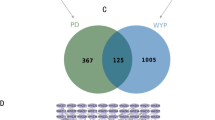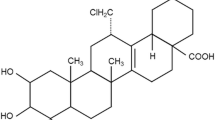Abstract
Parkinson disease (PD) is an age-related neurodegenerative disease, which is associated with the loss of dopaminergic neurons (DA neurons) in the substantia nigra pars compacta (SNpc), and neuroinflammation may lead to the occurrence of PD. Wuzi Yanzong Pill (WYP) has demonstrated neuroprotective and anti-inflammatory properties, but its molecular mechanism of action is still unclear. In this study, we used 1-methyl-4-phenyl-1,2,3,6-tetrahydropyridine (MPTP)-induced PD mice and LPS-mediated BV2 microglia to explore WYP intervention, anti-inflammatory effect and molecular mechanism in vivo and in vitro. The results showed that oral administration of WYP in MPTP-induced PD mice for 2 weeks ameliorated abnormal motor dysfunction, attenuated the loss of TH + neurons in SNpc, protected dopaminergic neurons, and inhibited the activation of microglia in MPTP-induced PD mice and LPS-stimulated BV2 cell. Meanwhile, WYP intervention inhibited the expression of IL-6, TNF-α, Pro-IL-1β, IL-1β, Pro-IL-18, IL-18 and enhanced the expression of IL-10 in the SNpc of PD mice. Simultaneously, WYP intervention inhibited the expression of NLRP3 inflammasome, accompanied by the decrease of the TLR4/MyD88/NF-κB pathway. However, the exact target and interaction of WYP on NLRP3 inflammasome and TLR4/MyD88/NF-κB pathway still needs to be further investigated.
Highlights
WYP treatment increased the number of DA neurons in SNpc, improved the behavioral performance of MPTP-induced PD mice, and inhibited the activation of microglia and astrocytes.
WYP inhibits inflammatory factors in PD mice and BV2 cells.
WYP intervention inhibits NLRP3 inflammasome expression while decreasing TLR4/MyD88/NF-κB pathway.






Similar content being viewed by others
Data Availability
Data are available from the corresponding author upon request.
References
Bellows S, Jankovic J (2022) Parkinsonism and tremor syndromes. J Neurol Sci 433:120018. https://doi.org/10.1016/j.jns.2021.120018
Cai M, Zhuang W, Lv E et al (2022) Kaemperfol alleviates pyroptosis and microglia-mediated neuroinflammation in Parkinson’s disease via inhibiting p38MAPK/NF-κB signaling pathway. Neurochem Int 152:105221. https://doi.org/10.1016/j.neuint.2021.105221
Campolo M, Paterniti I, Siracusa R et al (2019) TLR4 absence reduces neuroinflammation and inflammasome activation in Parkinson’s diseases in vivo model. Brain Behav Immun 76:236–247. https://doi.org/10.1016/j.bbi.2018.12.003
Chatterjee K, Roy A, Banerjee R et al (2020) Inflammasome and α-synuclein in Parkinson’s disease: a cross-sectional study. J Neuroimmunol 338:577089. https://doi.org/10.1016/j.jneuroim.2019.577089
Chen P, Zhang J, Wang C et al (2022) The pathogenesis and treatment mechanism of Parkinson’s disease from the perspective of traditional chinese medicine. Phytomedicine 100:154044. https://doi.org/10.1016/j.phymed.2022.154044
Cui B, Guo X, You Y et al (2019) Farrerol attenuates MPP+ -induced inflammatory response by TLR4 signaling in a microglia cell line. Phytother Res 33(4):1134–1141. https://doi.org/10.1002/ptr.6307+
Dorsey ER, Sherer T, Okun MS et al (2022) The emerging evidence of the Parkinson pandemic. J Parkinsons Dis 8(s1):S3. https://doi.org/10.3233/JPD-181474
Gustot A, Gallea JI, Sarroukh R et al (2015) Amyloid fibrils are the molecular trigger of inflammation in Parkinson’s disease. Biochem J 471(3):323–333. https://doi.org/10.1042/BJ20150617
Hang W, Fan HJ, Li YR et al (2022) Wuzi Yanzong pill attenuates MPTP-induced Parkinson’s Disease via PI3K/Akt signaling pathway. Metab Brain Dis 37(5):1435–1450. https://doi.org/10.1007/s11011-022-00993-8
Haque ME, Akther M, Jakaria M et al (2020) Targeting the microglial NLRP3 inflammasome and its role in Parkinson’s disease. Mov Disord 35(1):20–33. https://doi.org/10.1002/mds.27874
Holbrook JA, Jarosz-Griffiths HH, Caseley E et al (2021) Neurodegenerative disease and the NLRP3 inflammasome. Front Pharmacol 12:643254. https://doi.org/10.3389/fphar.2021.643254
Kwon HS, Koh SH (2020) Neuroinflammation in neurodegenerative disorders: the roles of microglia and astrocytes. Transl Neurodegener 9(1):42. https://doi.org/10.1186/s40035-020-00221-2
Lee JH, Kim HJ, Kim JU et al (2021) A Novel Treatment Strategy by Natural Products in NLRP3 inflammasome-mediated neuroinflammation in Alzheimer’s and Parkinson’s Disease. Int J Mol Sci 22(3):1324. https://doi.org/10.3390/ijms22031324
Li YR, Fan HJ, Chai Z et al (2020a) Neuroprotective and anti-inflammatory effects of Wuzi Yanzong Pills on Parkinson’s disease mice. China J Tradit Chin Med Pharm 35(7):3623–3626. ((in Chinese) https://kns.cnki.net/kcms/detail/detail.aspx?FileName=BXYY202007096&DbName=CJFQ2020)
Li YR, Fan HJ, Chai Z et al (2020b) Effects of Wuzi Yanzong Pills on behavior and oxidative stress in Parkinson’s disease mice. China J Tradit Chin Med Pharm 35(6):2795–2799.((in Chinese) https://kns.cnki.net/kcms/detail/detail.aspx?FileName=BXYY202006027&DbName=CJFQ2020)
Li Y, Xia Y, Yin S et al (2021) Targeting Microglial α-Synuclein/TLRs/NF-kappaB/NLRP3 Inflammasome Axis in Parkinson’s Disease. Front Immunol 12:719807. https://doi.org/10.3389/fimmu.2021.719807
Li YR, Fan HJ, Sun RR et al (2023) Wuzi Yanzong Pill plays a neuroprotective role in Parkinson’s Disease mice via regulating unfolded protein response mediated by endoplasmic reticulum stress. Chin J Integr Med 29(1):19–27. https://doi.org/10.1007/s11655-022-3727-0
Liu TW, Chen CM, Chang KH (2022) Biomarker of Neuroinflammation in Parkinson’s Disease. Int J Mol Sci 3(8):4148. https://doi.org/10.3390/ijms23084148
Mariathasan S, Weiss DS, Newton K et al (2006) Cryopyrin activates the inflammasome in response to toxins and ATP. Nature 440(7081):228–232. https://doi.org/10.1038/nature04515
Marogianni C, Sokratous M, Dardiotis E et al (2020) Neurodegeneration and Inflammation-An interesting interplay in Parkinson’s Disease. Int J Mol Sci 21(22):8421. https://doi.org/10.3390/ijms21228421
Pajares M, Rojo I, Manda A G (2020) Inflammation in Parkinson’s Disease: mechanisms and therapeutic implications. Cells 9(7):1687. https://doi.org/10.3390/cells9071687
Rui W, Li S, Xiao H, Xiao M et al (2020) Baicalein attenuates neuroinflammation by inhibiting NLRP3/caspase-1/GSDMD pathway in MPTP Induced mice Model of Parkinson’s Disease. Int J Neuropsychopharmacol 23(11):762–773. https://doi.org/10.1093/ijnp/pyaa060
Sengupta U, Kayed R (2022) Amyloid β, tau, and α-Synuclein aggregates in the pathogenesis, prognosis, and therapeutics for neurodegenerative diseases. Prog Neurobiol 214:102270. https://doi.org/10.1016/j.pneurobio.2022.102270
Simon DK, Tanner CM, Brundin P (2020) Parkinson Disease Epidemiology, Pathology, Genetics, and pathophysiology. Clin Geriatr Med 36(1):1–12. https://doi.org/10.1016/j.cger.2019.08.002
Soraci L, Gambuzza ME, Biscetti L et al (2022) Toll-like receptors and NLRP3 inflammasome-dependent pathways in Parkinson’s disease: mechanisms and therapeutic implications. J Neurol. https://doi.org/10.1007/s00415-022-11491-3
Sun L, Jiang T, Fan HJ et al (2018) Preparation of cell intervention solution of Wuzi Yanzong Pill and its anti-apoptotic effect on NTDs cells. Journal of Shanxi University (Natural Science Edition) 41(3):650–655.((in Chinese) https://kns.cnki.net/kcms/detail/detail.aspx?FileName=SXDR201803028&DbName=CJFQ2018)
Weintraub D, Aarsland D, Chaudhuri KR et al (2022) The neuropsychiatry of Parkinson’s disease: advances and challenges. Lancet Neurol 21(1):89–102. https://doi.org/10.1016/S1474-4422(21)00330-6
Xu XJ, Pan T, Fan HJ et al (2022) Modulation of M1/M2 polarization of microglia and LPS-induced polarization of BV2 cells in a mouse model of Parkinson’s disease by hypericin 15(8):1350–1358. ((in Chinese) https://kns.cnki.net/kcms/detail/detail.aspx?FileName=HQZY202208009&DbName=CJFQ2022)
Yang L, Zhou R, Tong Y et al (2020) Neuroprotection by dihydrotestosterone in LPS-induced neuroinflammation. Neurobiol Dis 140:104814. https://doi.org/10.1016/j.nbd.2020.104814
Yin R, Xue J, Tan Y et al (2021) The Positive Role and Mechanism of Herbal Medicine in Parkinson’s Disease. Oxid Med Cell Longev 2021:9923331. https://doi.org/10.1155/2021/9923331
Yu Q, Song FJ, Chen JF et al (2017) Antineuroinflammatory Effects of Modified Wu-Zi-Yan-Zong Prescription in β-Amyloid-Stimulated BV2 Microglia via the NF-κB and ERK/p38 MAPK Signaling Pathways. Evid Based Complement Alternat Med 2017:8470381. https://doi.org/10.1155/2017/8470381
Zhang X, Zhang Y, Li R et al (2020) Salidroside ameliorates Parkinson’s disease by inhibiting NLRP3-dependent pyroptosis. Aging 12(10):9405–9426. https://doi.org/10.18632/aging.103215
Acknowledgements
We would like to deeply appreciate all authors who performed all eligible studies which have been included in the present paper.
Funding
This study was supported by the National Natural Science Foundation of China (No.81703978), the National Young Qihuang Scholars Training Program(No.〔2022〕256), the Key National Science and Technology Cooperation Project of Shanxi Province(No.202204041101002), the Outstanding Youth Talents Program of Shanxi Province (No.〔2019〕35), the Natural Science Foundation of Shanxi Province (No.20210302124293), the Research Project supported by Shanxi Scholarship Council of China (No.2021 − 142), the Key science and technology R&D project of Jinzhong(No.Y213004), the Science and Technology Innovation Ability Cultivation Project, Shanxi University of Chinese Medicine (No.2020PY-JC-03, No.2021PY-QN-03, No.2022PY-TH-16, No.2022TD1013).
Author information
Authors and Affiliations
Contributions
Tao Pan, Qi Xiao and Hui-Jie Fan carried out the studies and drafted the manuscript. Lei Xu, Shao-Chen Qin and Li-Xia Yang participated in collecting data, performed the statistical analysis. Zhi Chai, Cun-gen Ma and Bo Zhang participated in its design. Bao-guo Xiao and Xiao-ming Jin participated in polishing the language and interpretation of data. All authors read and approved the final manuscript.
Corresponding authors
Ethics declarations
Conflict of interest
The authors declare that the research was conducted in the absence of any commercial or financial relationships that could be construed as a potential conflict of interest.
Ethics approval
Not applicable.
Consent to participate
Not applicable.
Consent to pulish
Not applicable.
Additional information
Publisher’s Note
Springer Nature remains neutral with regard to jurisdictional claims in published maps and institutional affiliations.
Electronic supplementary material
Below is the link to the electronic supplementary material.
Rights and permissions
Springer Nature or its licensor (e.g. a society or other partner) holds exclusive rights to this article under a publishing agreement with the author(s) or other rightsholder(s); author self-archiving of the accepted manuscript version of this article is solely governed by the terms of such publishing agreement and applicable law.
About this article
Cite this article
Pan, T., Xiao, Q., Fan, HJ. et al. Wuzi Yanzong Pill relieves MPTP-induced motor dysfunction and neuron loss by inhibiting NLRP3 inflammasome-mediated neuroinflammation. Metab Brain Dis 38, 2211–2222 (2023). https://doi.org/10.1007/s11011-023-01266-8
Received:
Accepted:
Published:
Issue Date:
DOI: https://doi.org/10.1007/s11011-023-01266-8




